We’ve poured countless hours into building, refining, and improving our mattress testing and scoring system. Our system is designed to create a clear and fair quantitative assessment for mattresses.
Using our scores as a guideline you can quickly and easily identify the mattresses that are best for you.
Below we’re going factor-by-factor so you can see exactly how we test and score mattresses.
Table Contents
Scoring Factors | Understanding Our Scores | Scoring Methodology | Cooling | Motion Transfer | Response Time | Edge Support | Sex | Pressure Relief | Off-Gassing | Company | Kid’s Scoring | Errors & Corrections
Scoring Factors
Our overall score is based on a weighted average of 8 scoring factors.

Each factor is given a weight based on the level of importance, which we combine together to determine the total score. Our individual factors are rounded up to one decimal place. Our overall mattress scores are rounded up to the second decimal place.
Non-Scoring Factors
In addition, we also test and analyze both sinkage and bounce. The objective measurements for sinkage and bounce are rounded up to two decimal places.
Casper Dream Max

Leesa Reserve
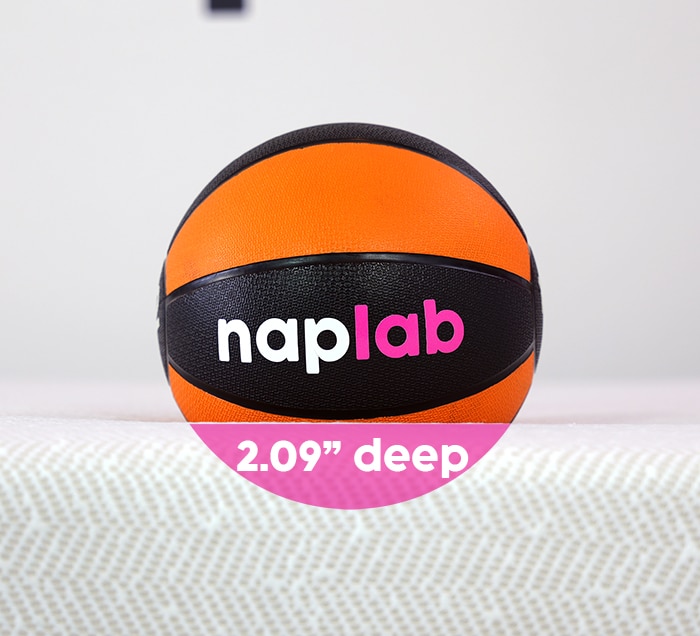
While we think bounce and sinkage are relevant and important to test and discuss, these are not scoring factors, as they are highly preferential. Some sleepers love deep sinkage, some love minimal sinkage. Being one or the other doesn’t make one inherently better or worse. The same can be said of bounce.
Understanding Our Scores
We use a 1-10 point grading scale. The more points a mattress scores in any given criteria, the better its performance is going to be.
10
Outstanding Score
9.0 – 9.9
Excellent Score
8.0 – 8.9
Good Score
7.0 – 7.9
Fair Score
6.0 – 6.9
Mediocre Score
5.0 – 5.9
Poor Score
4.0 – 4.9
Terrible Score
Scores below a 4.0 are increasing degrees of “Terrible”.
Scoring Methodology
Over time, we may find ways to improve our testing process, adjust scoring criteria, add / remove / revise scoring factors, and make other changes. These adjustments are designed to help ensure our scores create the most accurate and helpful mattress recommendations.
Our current scoring methodology is version 1.2.
If / when we update our scoring methodology we may also update mattress reviews at that time. At the top of all mattress review pages you’ll find the current scoring methodology which that mattress was tested under.
Below is a list of the major changes and updates to our scoring system from version 1.1 to version 1.2.
Why Did We Make These Changes?
We are always looking for ways to improve our reviews. Our 1.2 scoring update was aimed at making our scores, ratings, colors, and descriptions more intuitive. In addition, we added and revised several performance tests to improve their depth and accuracy, which also helped to create clearer distinctions between mattresses.
General Changes
- Wider score spread – we increased the spread of our scores to more intuitively show the differences between mattresses. In our 1.1 system, our scores ranged from 8.53 to 9.95. In our 1.2 system our scores now range from 6.23 to 9.82. This change resulted in all scores dropping from scoring system 1.1 to 1.2. In addition, it is harder for mattresses to earn the highest possible scores, creating a clearer distinction between mattresses.
- Color tiers – in our 1.1 system 9-10 was green, 8-8.9 was yellow, and sub 8 was red. In our 1.2 system 8-10 is green, 6-7.9 is yellow, and sub 6 is red. We made this change to align with our score spread changes.
- 7-Tier scale labels – we updated the specific words we use to describe certain scoring tiers. 10 = outstanding, 9-9.9 = excellent, 8-8.9 = good, 7-7.9 = fair, 6-6.9 = mediocre, 5-5.9 = poor, 4-4.9 = terrible. These words were updated from our 1.1 7-tier scale labels to make them more intuitive and easy to understand.
- Score weights – the individual factor weights for our overall score was updated to more accurately reflect the priorities and needs of most sleepers. In our 1.2 system, cooling is 20% (+0%) , motion transfer 15% (+5%), response 10% (-5%), edge support 10% (-5%), sex 10% (+5%), pressure relief 20% (+0%), off-gassing 5% (+0%), and company 10% (+0%).
New & Updated Scoring Factors
- Motion Transfer – Increased the difficulty required to score highly. In our 1.1 system, for every 1.0 m/s² above 5 m/s²(s), 0.25 points are lost. In our 1.2 system for every 1.0 m/s² above 5 m/s²(s), 0.45 points are lost.
- Response Time – Increased the difficulty required to score highly. In addition, we added fully recovered response time as a scoring factor, which we feel increases the accuracy of the score. Mostly recovered response time is still the most important, with 70% of the score weight. Full recovery has 30% of the score weight. In our 1.1 system, for every second above 0.5 seconds, 1 points are lost (this only factored in mostly recovered time). In our 1.2 system, for mostly recovered, for every second above 0.2 seconds, 6.25 points are lost. And for fully recovered, for every second above 0.3 seconds, 2.94 points are lost.
- Edge Support – Increased the difficulty required to score highly. In addition, we added lying edge support as a scoring factor, which we feel increases the accuracy of the score. Sitting edge support and lying edge support are each weighted at 50%. In our 1.1 system, for every inch above 3 inches, 0.5 points are lost (this only factored in sitting edge support). In our 1.2 system, for sitting edge support, for every inch above 3 inches, 1.25 points are lost. And for lying edge support, we use our standard 7 tier scale to rate performance.
- Sex – Increased the difficulty required to score highly. Score weights were changed to award slightly more weight to bounce and less to noise. In our 1.2 system, bounce is 65% (+5%), edge support 20% (+0%), noise 5% (+0%), pressure relief 5% (+0%), and cooling 5% (+0%). In addition, changes were made to how bounce is scored. In our 1.1 system, for bounce, for every inch below 10 inches, 0.25 points are lost. In our 1.2 system, for bounce, for every inch below 12 inches, 0.63 points are lost. In addition, changes were made to how edge support is scored (note: sex edge support follows the same equation as our standard sitting edge support score). In our 1.1 system, for every inch above 3 inches, 0.5 points are lost. In our 1.2 system, for sitting edge support, for every inch above 3 inches, 1.25 points are lost. Sex edge support only considers sitting edge support.
- Off-Gassing – Increased the difficulty required to score highly. In our 1.1 system, for every day above 0 days, 0.08 points are lost. In our 1.2 system, for every day above 0 days, 0.278 points are lost.
- Company – Increased the difficulty required to score highly. Trust was added as a scoring factor. In addition, scoring weights were changed. We made these changes as we felt they more accurately reflect the priorities of most sleepers. In our 1.1 system, trial, warranty, shipping, and returns were all evenly weighted at 25%. In our 1.2 system, trial is 15%, warranty 10%, shipping 5%, returns 20%, and trust 50%. The scoring scale for both shipping and return costs was increased.
You can find information on our legacy scoring systems below:
- Scoring System 1.1 – September 2021 to April 2024
- Scoring System 1.0 – August 2021 to September 2021
Cooling
Our cooling score is a subjective assessment based on:
- Mattress materials
- Mattress design
- Sinkage depth
- Objective data from our cooling test
- Subjective experience during our cooling test
Whether or not a mattress sleeps cool is highly subjective, as there are numerous factors that impact cooling performance. Our cooling score looks at the overall cooling picture, including objective temperature measurements, and we provide a score based on that overall view.
Below are the specifics we’re looking at when making our assessment.
Mattress Materials
What is the mattress made out of? Is it using traditional heat reactive memory foam or a more modern foam formulation? Does the foam have additives that could improve cooling like gel or copper?
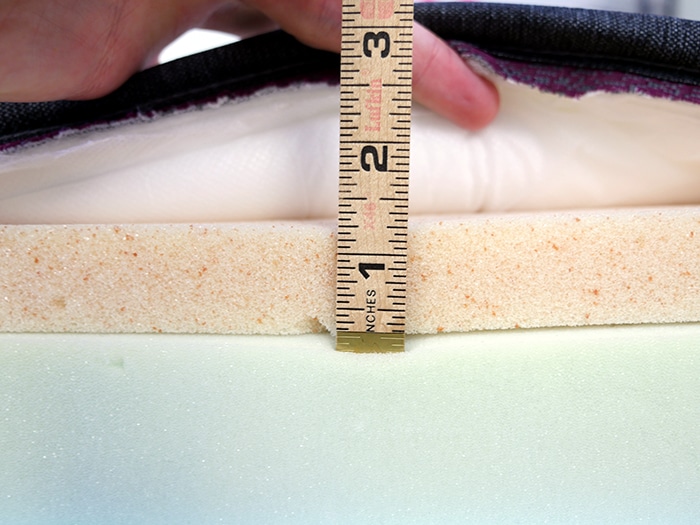
Is a cooler foam like latex or a latex-like poly foam used as opposed to memory foam? How thick are the comfort layers?
Does the mattress use a cooling cover? How long does that cover stay cool? And how cool is it at its maximum coolness?
The specific materials used within the mattress make a significant impact on how cool the mattress will be.
Mattress Design
Is it a memory foam mattress? Combo foam? All foam? Hybrid? Coil-on-Coil? Each mattress design type performs better or worse for cooling.
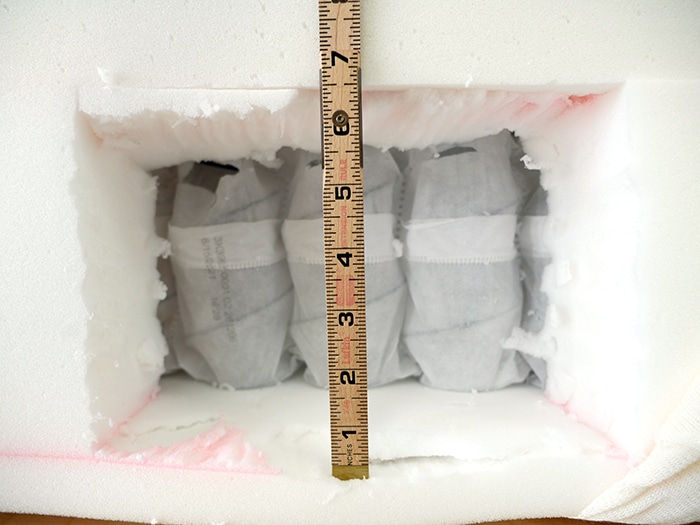
Does the mattress design incorporate elements that enhance breathability, for example, airflow channels cut within the foams? Aeration holes within the foam? Placing memory foam or other warmer materials further away from sleepers?
The mattress design elements greatly impact cooling performance.
Sinkage Depth
How deep do sleepers sink and how much hug and contour is placed on the body? The deeper you are the more material is physically touching and wrapping around your body, which can exacerbate heating issues.
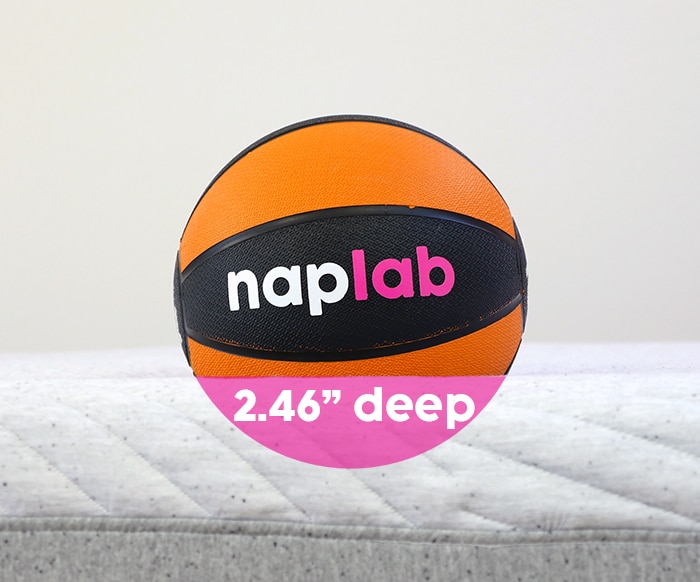
Objective Data
Our cooling test uses a thermal camera to get precise surface level temperatures on the mattress. To complete this test we start by taking a thermal image before anyone lies on the mattress.
Max Temp.
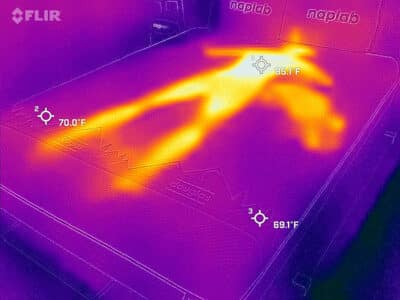
Ending Temp
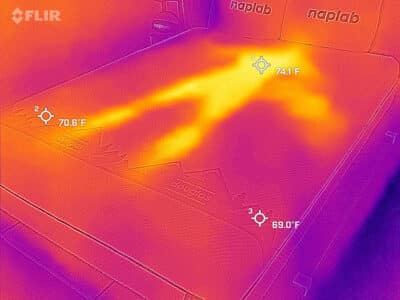
Next, we lie on the mattress for 15 minutes, allowing it to absorb our body heat. Finally, we get up from the mattress and take thermal photos at 6 different time markers (0, 1, 2, 3, 4, and 5 minutes).
We analyze this data to bring an objective data point into our overall score.
Here’s the scale we use to determine cooling scores:
10
Outstanding Cooling Score
9.0 – 9.9
Excellent Cooling Score
8.0 – 8.9
Good Cooling Score
7.0 – 7.9
Fair Cooling Score
6.0 – 6.9
Mediocre Cooling Score
5.0 – 5.9
Poor Cooling Score
4.0 – 4.9
Terrible Cooling Score
Motion Transfer
Our motion transfer score an objective score that uses accelerometer data precisely measure motion. To complete our motion transfer tests we place our accelerometer on one side of the mattress and drop a 12 pound medicine ball on the other side.
Acceleration is measured in meters per second squared (m/s2). If an object (in this case our accelerometer) accelerates in 5.0 m/s2 that means the speed is increasing by 5.0 meters every second. The higher the acceleration, the more motion is created on the mattress.
The initial medicine ball drop and rebound creates an acceleration range (IE, a minimum and maximum acceleration), which are the data points we use for our scores.
Here’s the scale we use to determine motion transfer scores:
10
Acceleration range ≤ 5.11 m/s²
9.0 – 9.9
5.11 m/s² < acceleration range ≤ 7.33 m/s²
8.0 – 8.9
7.33 m/s² < acceleration range ≤ 9.55 m/s²
7.0 – 7.9
9.55 m/s² < acceleration range ≤ 11.77 m/s²
6.0 – 6.9
11.77 m/s² < acceleration range ≤ 14.00 m/s²
5.0 – 5.9
14.00 m/s² < acceleration range ≤ 16.22 m/s²
4.0 – 4.9
16.22 m/s² < acceleration range ≤ 18.44 m/s²
Linear Function
f(x)=-0.45x+12.25
What It Means
For every 1.0 m/s² above 5.0 m/s²(s), 0.45 points are lost.
Response Time
Mattresses with a faster response time allow for easier movement of sleepers.
Response time is the amount of time it takes for a mattress to release its materials and respond back to its original shape. Memory foam mattresses tend to offer slower response time, which can leave some sleepers feeling stuck.
Our response time score is an objective score.
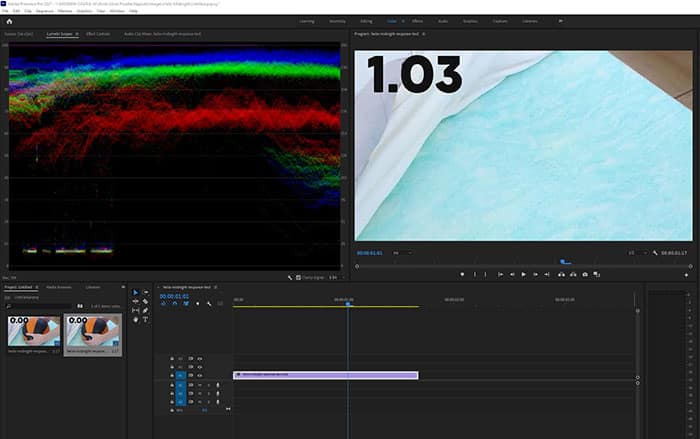
To test response time we place a 12 pound medicine ball on the mattress. Once it’s fully at rest we quickly remove the medicine ball. We record the process using a high FPS camera, overlay a stop watch, and then go frame-by-frame to assess exactly how long the mattress takes to recover.
On many mattresses, they will be mostly recovered fairly quickly, while a complete recovery of all foams can take longer. Mostly recovered to us means about 80%. I say “about” because this is a subjective assessment based on our analysis of the video footage.
In addition, we also measure the fully recovered response time. Our response time score is a weighted score. 70% of the score comes from mostly recovered time and 30% of the score comes from the fully recovered response time.

Here’s the scale we use to determine the mostly recovered score.
10
Response time ≤ 0.20 seconds
9.0 – 9.9
0.20 seconds < response time ≤ 0.36 seconds
8.0 – 8.9
0.36 seconds < response time ≤ 0.52 seconds
7.0 – 7.9
0.52 seconds < response time ≤ 0.68 seconds
6.0 – 6.9
0.68 seconds < response time ≤ 0.84 seconds
5.0 – 5.9
0.84 seconds < response time ≤ 1.00 seconds
4.0 – 4.9
1.00 seconds < response time ≤ 1.16 seconds
Linear Function
f(x)=-6.25x+11.25
What It Means
For every 1.0 seconds above 0.2 seconds, 6.25 points are lost.
And here’s the scale we use to determine the fully recovered score.
10
Response time ≤ 0.31 seconds
9.0 – 9.9
0.31 seconds < response time ≤ 0.65 seconds
8.0 – 8.9
0.65 seconds < response time ≤ 0.99 seconds
7.0 – 7.9
0.99 seconds < response time ≤ 1.33 seconds
6.0 – 6.9
1.33 seconds < response time ≤ 1.67 seconds
5.0 – 5.9
1.67 seconds < response time ≤ 2.01 seconds
4.0 – 4.9
2.01 seconds < response time ≤ 2.35 seconds
Linear Function
f(x)=-2.941x+10.882
What It Means
For every 1.0 seconds above 0.3 seconds, 2.94 points are lost.
Scoring Floor
The overall response time score, mostly recovered score, and fully recovered score have a scoring floor of 5.0. This simply means that the worst score that will be ever be given will be a 5.0.
Edge Support
Whether you sleep next to, sit near, or have sex on, edge support in a mattress is important. To test edge support we sit directly on the edge of the mattress. Using a yard stick and high resolution photographs, we analyze photos to get a precise measurement of the level of compression on the edge.
Sitting, 140 lbs.

Sitting, 200 lbs.
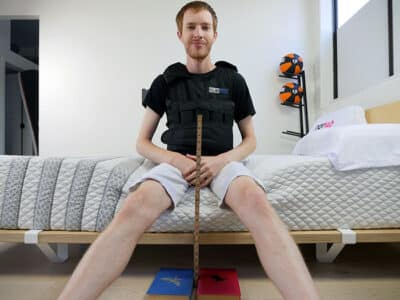
In addition, we lie directly on the edge of the mattress to determine a subjective rating for lying edge support performance.
Our edge support score is based on how deep the mattress sinks while sitting directly on the edge of the mattress and how supportive the mattress feels while lying directly on the edge. The total edge support score is weighted with 50% of the score coming from sitting edge support and 50% of the score coming from the lying edge support tests.

Here’s the scale we use to determine sitting edge support scores:
10
Sitting sinkage ≤ 3.04 inches
9.0 – 9.9
3.04 inches < sitting sinkage ≤ 3.84 inches
8.0 – 8.9
3.84 inches < sitting sinkage ≤ 4.64 inches
7.0 – 7.9
4.64 inches < sitting sinkage ≤ 5.44 inches
6.0 – 6.9
5.44 inches < sitting sinkage ≤ 6.24 inches
5.0 – 5.9
6.24 inches < sitting sinkage ≤ 7.04 inches
4.0 – 4.9
7.04 inches < sitting sinkage ≤ 7.84 inches
Linear Function
f(x)=-1.25x+13.75
What It Means
For every 1.0 inch above 3 inches, 1.25 points are lost.
And here’s the scale we use to determine lying edge support scores:
10
Outstanding lying support
9.0 – 9.9
Excellent lying support
8.0 – 8.9
Good lying support
7.0 – 7.9
Fair lying support
6.0 – 6.9
Mediocre lying support
5.0 – 5.9
Poor lying support
4.0 – 4.9
Terrible lying support
Sex
In addition to sleep, sex on the mattress is incredibly important to many. Certain mattress types may work with or against you when it comes to sex.
Our sex score is a simple equation where we look at 5 different factors. Each factor is given a specific weight based on how important we think that factor is for most people.

Our sex equation inputs for sitting edge support, pressure relief, and cooling are derived from those respective performance categories. Click the jump links above for more information on how we test for and determine the scores for those categories.
Below is our sex performance scoring scale:
10
Outstanding sex performance
9.0 – 9.9
Excellent sex performance
8.0 – 8.9
Good sex performance
7.0 – 7.9
Fair sex performance
6.0 – 6.9
Mediocre sex performance
5.0 – 5.9
Poor sex performance
4.0 – 4.9
Terrible sex performance
Sex Bounce
While we do specifically look at bounce as a separate test, the way we analyze bounce for general purpose sleeping doesn’t align well to sex performance. While tons of bounce isn’t always great for sleep, it’s almost always preferable for sex.
As a result, we use the same data from our bounce test, but with scale specific to sex. Our sex bounce scale rewards more points for mattresses that have more bounce.
Below is our sex bounce scale:
10
Bounce ≥ 11.93 inches
9.0 – 9.9
10.34 inches ≤ bounce < 11.93 inches
8.0 – 8.9
8.75 inches ≤ bounce < 10.34 inches
7.0 – 7.9
7.16 inches ≤ bounce < 8.75 inches
6.0 – 6.9
5.58 inches ≤ bounce < 7.16 inches
5.0 – 5.9
3.99 inches ≤ bounce < 5.58 inches
4.0 – 4.9
2.40 inches ≤ bounce < 3.99 inches
Linear Function
f(x)=0.63x+2.44
What It Means
For every 1.0 inch below 12 inches, 0.63 points are lost.
Scoring Floor
The sex bounce score has a scoring floor of 5.0. This simply means that the worst score that will be ever be given will be a 5.0.
Noise
To test noise, we jump on the mattress to determine how loud it is while under significant pressure. Our rating for noise is a subjective assessment.
Below is our sex noise scale:
10
Minimal noise
8.0
Moderate noise
6.0
High noise
4.0
Very high noise
Pressure Relief
When you lie on a good mattress you won’t experience any significant pressure points on your body. Mattresses that are too firm or too soft, not thick enough, lacking in comfort materials, sinking too much / too little, and / or using poor quality materials all have the potential to create pressure points.
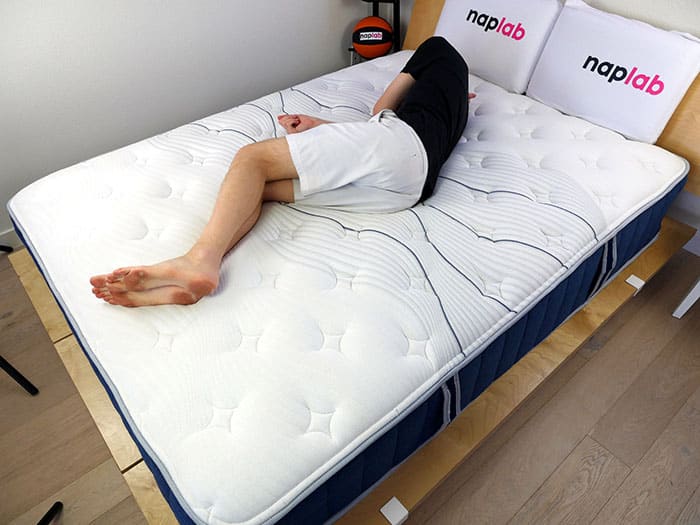
Objectively measuring pressure relief is impossible, in our view. As a result, we choose to make a subjective assessment of pressure relief based on our experience testing the product, material quality, comfort layer thickness, support layer thickness, and total mattress thickness.
In addition, beginning April 2024, we began including pressure mapping data and visual pressure mapping images. We use a highly advanced pressure mapping system to create these maps. These data and images provide an objective data point that helps inform our subjective pressure relief ratings.

Here’s the scale we use to determine pressure relief scores:
10
Outstanding pressure relief
9.0 – 9.9
Excellent pressure relief
8.0 – 8.9
Good pressure relief
7.0 – 7.9
Fair pressure relief
6.0 – 6.9
Mediocre pressure relief
5.0 – 5.9
Poor pressure relief
4.0 – 4.9
Terrible pressure relief
Off-Gassing
Off-gassing is the release of a gas that was trapped within a material. You can also think of this as the mattress smell. In many cases, foam mattresses have a strong smell when new.
Depending the materials, construction, quality, and other factors, that smell may be gone within a few hours or it may take many months.
Our off-gassing score is a subjective assessment based on the period of time it takes for any strong smell to fully dissipate.
Here’s the scale we use to determine off-gassing scores:
10
Off-gassing time ≤ 0.17 days
9.0 – 9.9
0.17 days < off-gassing time ≤ 3.77 days
8.0 – 8.9
3.77 days < off-gassing time ≤ 7.37 days
7.0 – 7.9
7.37 days < off-gassing time ≤ 10.97 days
6.0 – 6.9
10.97 days < off-gassing time ≤ 14.56 days
5.0 – 5.9
14.56 days < off-gassing time ≤ 18.16 days
4.0 – 4.9
18.16 days < off-gassing time ≤ 21.76 days
Linear Function
f(x)=-0.278x+10
What It Means
For every 1 day above 0 days, 0.278 points are lost.
Company
Our company score looks at 5 factors that we think reflect the most critical company policies, customer service, and trustworthiness.
Factors We Consider
- Trial Period
- Warranty
- Shipping
- Returns
- Trust
These 5 factors are given a specific weight based on how important we think that factor is.

Trial Period
How long is the trial period? The longer the trial period the better, as it provides sleepers with more time to make a decision on whether or not that mattress is the right choice.
10
180+ nights
8.0
100 nights
6.0
30 nights
0.0
0 nights
Warranty
A longer warranty is almost always better than a shorter warranty. Mattresses with longer warranties earn more points.
10
25+ years
8.0
10 years
0.0
0 years
Shipping
In our view, the most critical factor for shipping is whether or not it’s free. Paying less for shipping is always better than paying more for shipping.
10
$0 shipping
9.0 – 9.9
$25 shipping
8.0 – 8.9
$50 shipping
7.0 – 7.9
$75 shipping
6.0 – 6.9
$100 shipping
5.0 – 5.9
$150 shipping
4.0 – 4.9
$200 shipping
Returns
In our view, the most critical factor for returns is whether or not they are free. Not having to pay for a return / refund is always better than having to pay something.
10
$0 returns
9.0 – 9.9
$25 returns
8.0 – 8.9
$50 returns
7.0 – 7.9
$100 returns
6.0 – 6.9
$150 returns
5.0 – 5.9
$250 returns
4.0 – 4.9
No returns or very limited returns
Trust
In our view, trust is the most important factor with respect to the company score. As such, it is a 50% weight of the total company score. Our trust scoring is based on a subjective assessment by our team.
To determine the trust rating we consider the following:
- Does the company have a good or bad reputation with consumers?
- Does this company receive significant complaints or have significant customer service issues?
- Has the company been around long enough to have cultivated a trustworthy reputation?
- Is the company honest in their marketing, advertising, and product information?
- Has the company ever lied to NapLab and/or consumers?
- Has the company ever acted in bad faith with NapLab and/or with consumers?
- Has the company engaged in unethical behaviors?
- Does the company have anti-consumer policies or terms?
- Does the company have difficulty keeping products in stock, delivering products on time, or otherwise maintaining functional operations?
- Has the company behaved in any manner that would cause NapLab or consumers or distrust them?
Brands that are new to us start at an 8.0 “Good” level of trust. Most brands that we trust have a “good” level of trust. If / when brands lose our trust they will also earn lower trust scores. If / when brands do things to further increase our trust they will earn increasingly higher scores.
10
Outstanding Trust Score
9.0 – 9.9
Excellent Trust Score
8.0 – 8.9
Good Trust Score
7.0 – 7.9
Fair Trust Score
6.0 – 6.9
Mediocre Trust Score
5.0 – 5.9
Poor Trust Score
4.0 – 4.9
Terrible Trust Score
Country of Origin
Additionally, we include information on the country of origin where the mattress was manufactured. However, we do not use this as a data point to score.
Some users may find this information helpful, while others may find it irrelevant. We include the data point so you have the information in the event it’s a factor that’s important to you.
Kids Mattress Scoring
To score mattresses for children and kids we use a modified version of our standard scoring system. The modified version drops irrelevant scoring factors, so that we only include factors that could impact the performance of the mattress for children.
Errors & Corrections
Our system of testing and scores is complex, difficult to execute, and difficult to maintain. So there is no question that at times we may execute a test wrong, calculate a score wrong, forget to update a score or analysis, or make other errors.
We make every effort to check and double check our work so that we keep those mistakes to an absolute minimum. But, they will still happen.
If you come across an error, you think or data isn’t right, or see something else that just doesn’t make sense, please let us know here. We will always correct errors and we’re happy to explain anything that needs more clarity.
Suggestions
Do you have a suggestion for how we could make our scoring system better? Please send us your feedback here.



